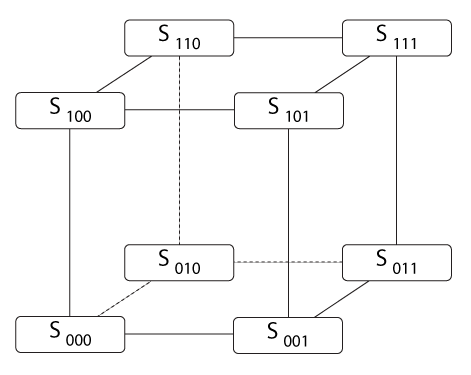Li, Rinzel, 1994
Model Status
This is the original unchecked version of the model imported from the previous CellML model repository, 24-Jan-2006.
Model Structure
Cytosolic calcium ([Ca2+]i) shows complex spatio-temporal oscillatory profiles in a large number of cell types. A number of mathematical models have been published that attempt to model the temporal [Ca2+]i oscillations. Some, such as the Keizer and De Young model (see The De Young-Keizer model, 1992) assume that IP3 is necessarily oscillatory. They constructed a model of the IP3 receptor/channel by assuming that three equivalent and independent subunits are involved in Ca2+ conduction. Each subunit has three binding sites: one for IP3, one for Ca2+ activation, and one for Ca2+ inactivation. Thus, each subunit may exist in eight states with transitions governed by second-order (association) and first-order (dissociation) rate constants (see below). All three subunits must be in the state S110 (one IP3 and one activating Ca2+ bound) for the channel to be open and conducting.
In 1994, Yue-Xian Li and John Rinzel analysed the nine-variable De Young-Keizer model (1992) and reduced it to a two-variable system. Their reduced system is analogous in form to the classic Hodgkin-Huxley equations (see The Hodgkin-Huxley Squid Axon Model, 1952) for plasma membrane electrical excitability. [Ca2+]i dynamics in this model thus involve endoplasmic reticulum (ER) membrane-associated excitability. Assuming further that the binging of IP3 does not depend on Ca2+ occupancy at the inactivation site, Li and Rinzel obtain a "minimal" model which still retains the ability to reproduce experimental observations.
The complete original paper reference is cited below:
Equations for InsP3 Receptor-mediated [Ca2+]i Oscillations Derived from a Detailed Kinetic Model: A Hodgkin-Huxley Like Formalism, Yue-Xian Li and John Rinzel, 1994, Journal of Theoretical Biology , 166, 461-473. (A PDF of the article is available to subscribers on the IDEAL website.) PubMed ID: 8176949
In addition to the original version of the Li and Rinzel mathematical model, the system described in equation nine of the paper has also been implemented in CellML as a separate model (see for the downloads of both models in various formats). This is a set of three coupled differential equations, namely:
-
One equation for describing the calcium dynamics;
-
One equation which represents the gate-shutting variable h; and
-
One equation which describes the influx of extracellular calcium into the cell cytosol through the plasma membrane
The advantage of reducing the model to this set of three equations is that it more simple, yet it still retains the ability to explain oscillatory behaviours caused by the calcium dynamics. All the model parameters have been set according to those which are provided in Figure 5(a) of the paper.
The raw CellML descriptions of the Li and Rinzel 1994 model can be downloaded in various formats as described in .
 |
| A schematic diagram of the kinetics of an IP3 receptor/channel subunit. |

